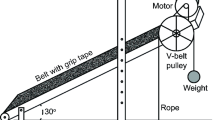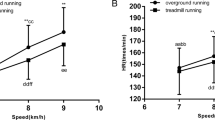Abstract
This study aimed to determine the net energy expenditure (EENET) required for overground walking and running 1200 m in a sample of healthy adolescent boys and girls. A secondary purpose was to describe the effect of body composition on energy expenditure (EE) of walking versus running. Twenty healthy adolescents (9 boys, 11 girls) aged 15.85 ± 2.80 years performed 2 field tests in regular outdoor conditions: overground walking (1.64 ± 0.17 m/s) and submaximal running (3.13 ± 0.42 m/s), at a self-selected steady pace. EE was measured via indirect calorimetry. Paired sample t-tests were used to determine if there were differences between walking and running conditions and mean percentage differences were estimated for various physiological parameters. Differences in EENET between conditions were performed for both genders using a two (condition) by two (gender) analysis of variance repeated measures design, with fat free mass as a covariate. Speed increased by 90.43% between the 2 conditions, while the different components of EE increased by almost 20%. Running elicited a significantly greater EENET than walking for both genders; however, boys’ and girls’ EE did not differ significantly. When EENET was adjusted for fat free mass, there was a statistically significant condition × fat free mass effect. The findings in this study indicate that both adolescent boys and girls expend more energy during running than walking, without being affected by body composition. Body mass and fat free mass significantly correlated with EE only during running. In addition, the trained participants of the study optimized locomotion to minimize EE.


Similar content being viewed by others

Availability of Data and Materials
Due to the small sample size and potentially identifiable markers, the data will not be made available.
Code Availability
Not applicable.
Notes
According to the American College of Sports Medicine [2], speed between 6 and 8 km/h (1.67 and 2.22 m/s) is considered a transitional speed between walking and running and should be avoided in experimental procedures.
References
Adamakis M. Comparing the validity of a GPS monitor and a smartphone application to measure physical activity. J Mob Technol Med. 2017;6(2):28–38. https://doi.org/10.7309/jmtm.6.2.4.
American College of Sports Medicine. ACSM’s guidelines for exercise testing and prescription. 7th ed. Baltimore: Lippincott Williams and Wilkins; 2006.
Batliner ME, Kipp S, Grabowski AM, Kram R, Byrnes WC. Does metabolic rate increase linearly with running speed in all distance runners? Sports Med Int Open. 2017;2(1):E1–8. https://doi.org/10.1055/s-0043-122068.
Cohen J. Statistical power analysis for the behavioral sciences. 2nd ed. New York: Lawrence Erlbaum Associates; 1988.
Compher C, Frankenfield D, Keim N, Roth-Yousey L. Best practice methods to apply to measurement of resting metabolic rate in adults: a systematic review. J Am Diet Assoc. 2006;106(6):881–903. https://doi.org/10.1016/j.jada.2006.02.009.
Coutts AJ, Duffield R. Validity and reliability of GPS devices for measuring movement demands of team sports. J Sci Med Sport. 2010;13(1):133–5. https://doi.org/10.1016/j.jsams.2008.09.015.
Daniels J, Daniels N. Running economy of elite male and elite female runners. Med Sci Sports Exerc. 1992;24(4):483–9.
Faul F, Erdfelder E, Lang AG, Buchner A. G*Power 3: a flexible statistical power analysis program for the social, behavioral, and biomedical sciences. Behav Res Methods. 2007;39(2):175–91. https://doi.org/10.3758/bf03193146.
Geyer H, Seyfarth A, Blickhan R. Compliant leg behaviour explains basic dynamics of walking and running. Proc R So B. 2006;273(1603):2861–7. https://doi.org/10.1098/rspb.2006.3637.
Hall C, Figueroa A, Fernhall B, Kanaley JA. Energy expenditure of walking and running: comparison with prediction equations. Med Sci Sports Exerc. 2004;36(12):2128–34. https://doi.org/10.1249/01.mss.0000147584.87788.0e.
Harrell JS, McMurray RG, Baggett CD, Pennell ML, Pearce PF, Bangdiwala SI. Energy costs of physical activities in children and adolescents. Med Sci Sports Exer. 2005;37(2):329–36. https://doi.org/10.1249/01.MSS.0000153115.33762.3F.
Helgerud J, Storind O, Hoff J. Are there differences in economy at different velocities for well-trained distance runners? Eur J Appl Physiol. 2009;108(6):1099–105. https://doi.org/10.1007/s00421-009-1218-z.
Jones AM, Doust J. A 1% grade most accurately reflects the energetic cost of outdoor running. J Sports Sci. 1996;14(4):321–7. https://doi.org/10.1080/02640419608727717.
Li S, Xue JJ, Hong P, Song C, He ZH. Comparison of energy expenditure and substrate metabolism during overground and motorized treadmill running in Chinese middle-aged women. Sci Rep. 2020;10(1):1815. https://doi.org/10.1038/s41598-020-58791-0.
Loftin M, Sothern M, Koss C, Tuuri G, VanVrancken C, Kontos A, Bonis M. Energy expenditure and influence of physiologic factors during marathon running. J Strength Cond Res. 2007;21(4):1188–91. https://doi.org/10.1519/R-22666.1.
Loftin M, Waddell DE, Robinson JH, Owens SG. Comparison of energy expenditure to walk or run a mile in adult normal weight and overweight men and women. J Strength Cond Res. 2010;24(10):2794–8. https://doi.org/10.1519/JSC.0b013e3181cc26cd.
Long LL III, Srinivasan M. Walking, running, and resting under time, distance, and average speed constraints: optimality of walk–run–rest mixtures. J R Soc Interface. 2013;10(81):20120980. https://doi.org/10.1098/rsif.2012.0980.
Maffeis C, Schutz Y, Schena F, Zaffanello M, Pinelli L. Energy expenditure during walking and running in obese and nonobese prepubertal children. J Pediatr. 1993;123(2):193–9. https://doi.org/10.1016/S0022-3476(05)81688-9.
Mardia KV. The effect of nonnormality on some multivariate tests and robustness to nonnormality in the linear model. Biometrika. 1971;58(1):105–21. https://doi.org/10.2307/2334321.
McLaughlin JE, King GA, Howley ET, Bassett DR, Ainswirth BE. Validation of the COSMED K4b2 portable metabolic system. Int J Sports Med. 2001;22(4):280–4. https://doi.org/10.1055/s-2001-13816.
Miller JR, Van Hooren B, Bishop C, Buckley JD, Willy RW, Fuller JT. A systematic review and meta-analysis of crossover studies comparing physiological, perceptual and performance measures between treadmill and overground running. Sports Med. 2019;49(5):763–82. https://doi.org/10.1007/s40279-019-01087-9.
Mohler BJ, Thompson WB, Creem-Regehr SH, Pick HL, Warren WH. Visual flow influences gait transition speed and preferred walking speed. Exp Brain Res. 2007;181(2):221–8. https://doi.org/10.1007/s00221-007-0917-0.
Noor MN, Yahaya AS, Ramli NA, Al Bakri AMM. Filling missing data using interpolation methods: study on the effect of fitting distribution. Eng Mater. 2013;594–595:889–95. https://doi.org/10.4028/www.scientific.net/KEM.594-595.889.
Oja P, Kelly P, Murtagh EM, Murphy MH, Foster C, Titze S. Effects of frequency, intensity, duration and volume of walking interventions on CVD risk factors: a systematic review and meta-regression analysis of randomised controlled trials among inactive healthy adults. Br J Sports Med. 2018;52(12):769–75. https://doi.org/10.1136/bjsports-2017-098558.
Pauley A, Dixon CB, Rawson ES, McConnell TR, Andreacci JL. The impact of body composition on energy expenditure during walking and running in young adults. JEP Online. 2016;19(1):66–76.
Physical Activity Guidelines Advisory Committee. Physical activity guidelines advisory committee scientific report. Washington, DC: U.S. Department of Health and Human Services; 2018. Available via https://health.gov/paguidelines/second-edition/report/pdf/PAG_Advisory_Committee_Report.pdf. Accessed 20 Oct 2020.
Rawstorn JC, Maddison R, Ali A, Foskett A, Gant N. Rapid directional change degrades GPS distance measurement validity during intermittent intensity running. PLoS ONE. 2014;9(4): e93693. https://doi.org/10.1371/journal.pone.0093693.
Scott MT, Scott TJ, Kelly VG. The validity and reliability of global positioning systems in team sport: a brief review. J Strength Cond Res. 2016;30(5):1470–90. https://doi.org/10.1519/JSC.0000000000001221.
Slaughter MH, Lohman TG, Boileau RA, Horswill CA, Stillman RJ, Van Loan MD, Bemben DA. Skinfold equations for estimating of body fatness in children and youth. Hum Biol. 1988;60(5):709–23 (PMID:3224965).
Srinivasan M, Ruina A. Computer optimization of a minimal biped model discovers walking and running. Nature. 2006;439(7072):72–55. https://doi.org/10.1038/nature04113.
Stamatakis E, Kelly P, Strain T, Murtagh EM, Ding D, Murphy MH. Self-rated walking pace and all-cause, cardiovascular disease and cancer mortality: Individual participant pooled analysis of 50 225 walkers from 11 population British cohorts. Br J Sports Med. 2018;52(12):761–8. https://doi.org/10.1136/bjsports-2017-098677.
Twisk J, de Vente W. Attrition in longitudinal studies: How to deal with missing data. J Clin Epidemiol. 2002;55(4):329–37. https://doi.org/10.1016/s0895-4356(01)00476-0.
van Ingen Schenau GJ. Some fundamental aspects of the biomechanics of overground versus treadmill locomotion. Med Sci Sports Exer. 1980;12(4):257–61. https://doi.org/10.1249/00005768-198024000-00005.
Weir JB. New methods for calculating metabolic rate with special reference to protein metabolism. J Physiol. 1949;109(1–2):1–9 (PubMed:15394301).
Wilkin LD, Cheryl AP, Haddock BL. Energy expenditure comparison between walking and running in average fitness individuals. J Strength Cond Res. 2012;26(4):1039–44. https://doi.org/10.1519/JSC.0b013e31822e592c.
Funding
Not applicable.
Author information
Authors and Affiliations
Corresponding author
Ethics declarations
Conflict of Interest
No potential conflict of interest was reported by the author.
Consent to Participate
Written informed assent and consent was obtained from participants and their parents/guardians, respectively.
Consent to Publication
Publication has been approved by the author.
Rights and permissions
About this article
Cite this article
Adamakis, M. Energy Expenditure of Adolescents During Overground Walking and Running. J. of SCI. IN SPORT AND EXERCISE 5, 44–52 (2023). https://doi.org/10.1007/s42978-021-00157-7
Received:
Accepted:
Published:
Issue Date:
DOI: https://doi.org/10.1007/s42978-021-00157-7



